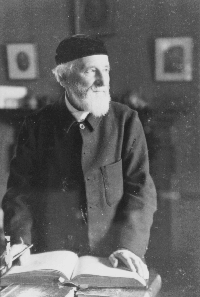Edwin Abbott Abbott
Edwin Abbott Abbott FBA (20 December 1838 – 12 October 1926)[1] was an English schoolmaster, theologian, and Anglican priest, best known as the author of the novella Flatland (1884).
Edwin Abbott Abbott | |
|---|---|
 | |
| Born | 20 December 1838 Marylebone, London, England |
| Died | 12 October 1926 (aged 87) Hampstead, London, England |
| Nationality | British |
| Education | City of London School St John's College, Cambridge |
| Occupation | Teacher, author |
| Known for | Flatland |
| Parent(s) | Edwin and Jane Abbott |
Biography
Edwin Abbott Abbott was the eldest son of Edwin Abbott (1808–1882), headmaster of the Philological School, Marylebone, and his wife, Jane Abbott (1806–1882). His parents were first cousins.
He was educated at the City of London School and at St John's College, Cambridge, where he took the highest honours of his class in classics, mathematics and theology, and became a fellow of his college. In particular, he was 1st Smith's prizeman in 1861.[2][lower-alpha 1] In 1862 he took orders. After holding masterships at King Edward's School, Birmingham, he succeeded G. F. Mortimer as headmaster of the City of London School in 1865, at the early age of 26. There, he oversaw the education of future Prime Minister H. H. Asquith. Abbott was Hulsean lecturer in 1876.[3]
He retired in 1889, and devoted himself to literary and theological pursuits. Abbott's liberal inclinations in theology were prominent both in his educational views and in his books. His Shakespearian Grammar (1870) is a permanent contribution to English philology. In 1885, he published a life of Francis Bacon. His theological writings include three anonymously published religious romances – Philochristus (1878), where he tried to raise interest in Gospels reading, Onesimus (1882), and Silanus the Christian (1908).[3]
More weighty contributions are the anonymous theological discussion The Kernel and the Husk (1886), Philomythus (1891), his book The Anglican Career of Cardinal Newman (1892), and his article "The Gospels" in the ninth edition of the Encyclopædia Britannica, embodying a critical view which caused considerable stir in the English theological world. He also wrote St Thomas of Canterbury, his Death and Miracles (1898), Johannine Vocabulary (1905), Johannine Grammar (1906).[3]
Abbott also wrote educational text books, one being "Via Latina: First Latin Book" which was published in 1898 and distributed around the world within the education system.
Flatland

Abbott's best-known work is his 1884 novella Flatland: A Romance of Many Dimensions which describes a two-dimensional world and explores the nature of dimensions. It has often been categorized as science fiction although it could more precisely be called "mathematical fiction".
With the advent of modern science fiction from the 1950s to the present day, Flatland has seen a revival in popularity,[4] especially among science fiction and cyberpunk fans.[5] Many works have been inspired by the novella, including novel sequels and short films.[5]
Bibliography
- Shakespearian Grammar (1870)
- Flatland (1884)
- Francis Bacon: An Account of His Life and Works (1885)
- Philochristus (1878)
- Onesimus (1882)
- The Kernel and the Husk (1886)
- Philomythus (1891)
- The Anglican Career of Cardinal Newman (1892)
- St Thomas of Canterbury, his Death and Miracles (1898)
- Johannine Vocabulary (1905)
- Johannine Grammar (1906)
- Silanus the Christian (1908)
See also
Notes
- This seems to be an error by Venn: Colby's preface to Abbott's Flatland states that Abbott was 7th Senior Optime, Senior Classic and 1st Chancellor's Medallist in 1861; William Steadman Aldis was 1st Smith's Prizeman in 1861.
References
- Thorne and Collocott 1984, p. 2.
- "Abbott, Edwin Abbott (ABT857EA)". A Cambridge Alumni Database. University of Cambridge.
-

- Clute and Nicholls 1995, p. 1.
- Harper 2010
Further reading
- Clute, John; Nicholls, Peter (1995). The Encyclopedia of Science Fiction. New York: St. Martin's Griffin. p. 1. ISBN 0-312-13486-X.

- Harper, Lila Marz, ed. (2010). Flatland. Peterborough, Ontario, Canada: Broadview. ISBN 978-1-55111-690-7.
- Thorne, J.O.; T.C. Collocott (1984). Chambers Biographical Dictionary. Edinburgh: Chambers Harrap. ISBN 0-550-18022-2.
- Tuck, Donald H. (1974). The Encyclopedia of Science Fiction and Fantasy. Chicago: Advent. p. 1. ISBN 0-911682-27-9.
External links
| Wikiquote has quotations related to: Edwin Abbott Abbott |
| Wikisource has original works written by or about: Edwin Abbott Abbott |
| Wikimedia Commons has media related to Edwin Abbott Abbott. |
- Portraits of Edwin Abbott at the National Portrait Gallery, London

- O'Connor, John J.; Robertson, Edmund F., "Edwin Abbott Abbott", MacTutor History of Mathematics archive, University of St Andrews.
- Works by Edwin Abbott Abbott at Project Gutenberg
- Works by Edwin Abbott Abbott at Faded Page (Canada)
- Works by or about Edwin Abbott Abbott at Internet Archive
- Works by Edwin Abbott Abbott at LibriVox (public domain audiobooks)

- Edwin Abbott Abbott on IMDb
- Edwin Abbott Abbott at the Internet Book List
- Edwin Abbott Abbott at the Internet Book Database of Fiction
- Edwin Abbott Abbott at the Internet Speculative Fiction Database
- Free audiobook narration of Flatland
- Online text of Flatland
- Full text of A Shakespearian Grammar on the Tufts University Perseus Digital Library
- Thomas Banchoff collection of materials relating to Edwin Abbott Abbott at the Brown University John Hay Library